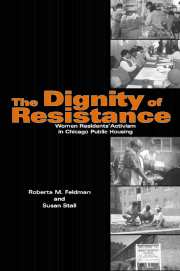Book contents
- Frontmatter
- Contents
- Foreword by Sheila Radford-Hill
- Preface and Acknowledgments
- PART I INTRODUCTION
- PART II WENTWORTH GARDENS' HISTORIC CONTEXT
- PART III EVERYDAY RESISTANCE IN THE EXPANDED PRIVATE SPHERE
- PART IV TRANSGRESSIVE RESISTANCE IN THE PUBLIC SPHERE
- PART V CONCLUSIONS
- Epilogue
- Appendix A Timeline of Wentworth Gardens Resident Activists' Key Initiatives
- Appendix B A Demographic Profile of the Resident Community Activists Interviewed, 1992–1998
- References
- Index
Foreword by Sheila Radford-Hill
Published online by Cambridge University Press: 06 July 2010
- Frontmatter
- Contents
- Foreword by Sheila Radford-Hill
- Preface and Acknowledgments
- PART I INTRODUCTION
- PART II WENTWORTH GARDENS' HISTORIC CONTEXT
- PART III EVERYDAY RESISTANCE IN THE EXPANDED PRIVATE SPHERE
- PART IV TRANSGRESSIVE RESISTANCE IN THE PUBLIC SPHERE
- PART V CONCLUSIONS
- Epilogue
- Appendix A Timeline of Wentworth Gardens Resident Activists' Key Initiatives
- Appendix B A Demographic Profile of the Resident Community Activists Interviewed, 1992–1998
- References
- Index
Summary
I first arrived at Wentworth Gardens in the spring of 1982. I took the number 24 bus from downtown Chicago and got off at 35th and Wentworth Street, right in front of the old Chicago White Sox stadium, Comiskey Park. I walked the few short blocks past Tyler's Restaurant, past the grocery store, past Progressive Baptist Church, past T. E. Brown Apartments, post the senior citizens center, and through the modest neighborhood filled with homes that were well past their prime. As I walked, I was struck by the sense of neighborhood that these people of meager resources had somehow captured like lighting in a bottle. The easy familiarity and gossipy love that neighbors have for each other would lead me right to the office of the Wentworth Local Advisory Council (LAC).
As a trainer/organizer for Designs for Change (DFC), an education advocacy organization, I had the mission of organizing parents of special education children so that they could actively challenge the special education policies at their school. The neighborhood school was the Robert S. Abbott Elementary School, a once proud elementary school named for the famous founder of the Chicago Defender. Sadly, the memory of Robert S. Abbott was tarnished by a school plagued with low achievement and a disproportionate number of special education identified students.
With the support of the Wentworth LAC, I visited the development frequently and confirmed what a DFC analysis of the school's enrollment patterns had shown, namely, that children from Wentworth Gardens were being inappropriately placed in special education classes.
- Type
- Chapter
- Information
- The Dignity of ResistanceWomen Residents' Activism in Chicago Public Housing, pp. xi - xivPublisher: Cambridge University PressPrint publication year: 2004
- 1
- Cited by



